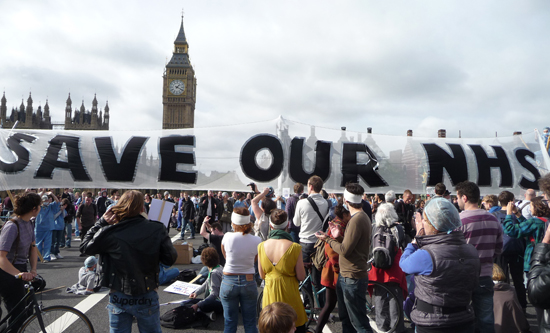
As the financial crisis engulfing the NHS deepens, Conservative promises to create a ‘seven-days-a-week’ NHS by 2020 already ring hollow. Its election commitment to invest an extra £8bn a year by 2020 will at best keep the NHS standing still: more likely, it will involve further cuts to an increasingly threadbare service.
Desperate pleas for an immediate cash injection of £1bn into the NHS demonstrate how close it is to a financial abyss. Hospital, mental health and community services collectively ended 2014/15 £821m in deficit, nearly eight times the 2013/14 figure of £107m. The total deficit for acute hospitals was just over £1bn, with Barts £80m overspent and foundation trust Kings College £47m overspent. On current trends, the projected NHS deficit for 2015/16 is in excess of £2bn.
The key to this is five years of severe cuts. Although the ConDem coalition told us that real spending on the NHS had gone up annually by 1%, the NHS inflation rate is 4%. This means the NHS has faced cuts of 3% per annum. NHS trusts are in a double bind: on the one hand, they have to cut staff in order to meet financial targets; on the other they have to maintain safe staffing levels. So cutting posts means having to employ much more expensive agency staff to fill the gaps. Spending on agency staff amounted to £1.8bn in 2014/15, twice the projected £766m.
The government promise of an extra £8bn a year hides the fact that the real funding gap identified in the December 2014 Stevens review: The NHS Five Year Forward View is £30bn. To make the figures politically palatable, its author, who is head of NHS England, a former president of the global health division of UnitedHealth Group, and before that adviser to Tony Blair on health policy, decided that £22bn of the gap would have to be met by ‘efficiency savings’. These would require an annual 2% improvement in productivity. The best annual achievement over the last 20 years has been 1.5%; if the NHS managed to sustain this for each of the next five years, the funding gap will be £16bn, not £8bn. In reality, the gap will be at least £20bn.
Stevens’s £30bn is what is required just to keep the NHS standing still; it cannot begin to meet the costs of the government’s promised seven-days-a week NHS for both GP and hospital services. The costs would be enormous, and its attainment would depend on an increase in clinical staffing which will take over a decade to achieve. Studies currently estimate that there will be a shortfall of 190,000 nurses by 2016. The number of district nurses has dropped by 47% over ten years, and in 2013 only five qualified in London and 265 across Britain. Four of out five hospitals missed their safe staffing targets and the National Institute for Clinical Excellence says £400m a year is needed to make ward staffing levels safe. There is no shortage of people wanting to enter the nursing profession: but education cuts have savagely reduced the number of training places available. Hence over 90,000 nurses registered to work in Britain were trained overseas. Poorer countries are being looted of highly-trained individuals.
A British Medical Journal study looked at what is needed to fulfil the Conservatives’ promises of seven-day GP access. It takes ten years to train a GP, so conjuring up any increase in their numbers by 2020 is impossible. Health Secretary Jeremy Hunt talks of half of all newly-qualified doctors going into general practice. However, this would not be enough to maintain, let alone expand, the service. GP numbers as a proportion of all doctors have fallen from 34% in 1995 to 26% today. The ConDem government wanted to recruit 3,250 new GP trainees per year for each of the last four years; it fell short by 2,200. Currently nearly two-thirds of GPs are considering early retirement. The GP vacancy rate rose from 4.2% in 2011 to 7.9% in 2013.
In the meantime all the other pressures on the NHS continue to mount: cuts in social services preventing the discharge of patients from hospital for lack of community or domestic care; crippling PFI repayments swelling the coffers of banks and multinationals; the continual fragmentation and privatisation of services; the vast bureaucracy needed to manage the internal market. Rationing is on the increase. The drive to provide services at the lowest price continues to damage health care and hammer the poorest and most vulnerable who are disproportionately affected by welfare cuts and austerity. Fighting to defend the NHS is part and parcel of the fight against austerity.
Robert Clough and Hannah Caller
Fight Racism! Fight Imperialism! 245 June/July 2015




